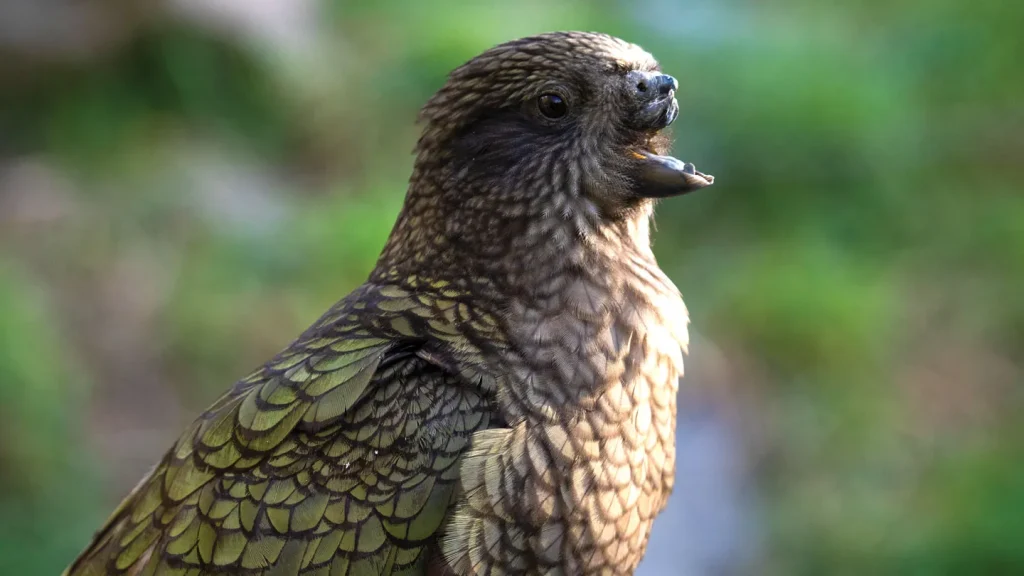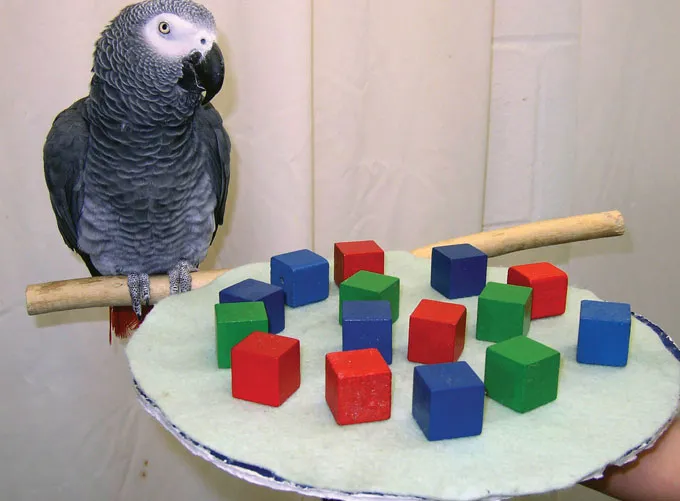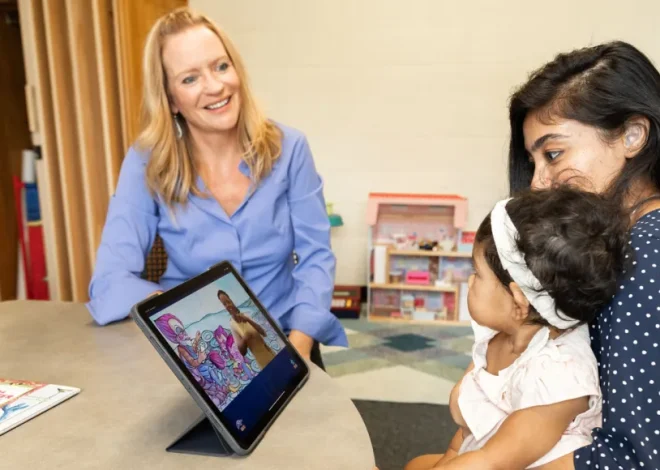Bruce, the kea, has an expression of continual astonishment on his olive-green parrot since he is missing his upper beak. The ones who are shocked are scientists, though.
With its long, sharp beak, the common kea (Nestor notabilis) is an excellent tool for extracting insects from decaying logs and tearing roots from the earth in the alpine forests of New Zealand. Since at least 2012, when he was taken in as a fledgling and given a home at the Willowbank Wildlife Reserve in Christchurch, Bruce has been devoid of the upper portion of his beak.
Because of the flaw, Bruce is unable to forage on his own. Additionally, maintaining his feathers should be an impossibility. When Amalia Bastos, a comparative psychologist, and her colleagues visited the reserve in 2021 to study keas, the zookeepers noticed something strange: Bruce appeared to have discovered a way to preen using tiny stones.
“We thought that was strange,” Bastos of Johns Hopkins University recalls.
Bruce was closely monitored by the researchers for nine days, and if he began to clean his feathers, videos were taken right away. The researchers published their findings in Scientific Reports in 2021, revealing that Bruce had, in fact, created his own workaround for preening.
Bruce first chooses the appropriate instrument, using his tongue to roll stones around in his mouth and spit out potential contenders until he finds one he likes, usually something pointed. He then places the pebble between his bottom beak and tongue. He picks through his feathers after that.
According to Bastos, “It’s crazy because the behavior was not present in the wild.” Bruce wasn’t old enough to know how to preen when he got to Willowbank. And this is how no other bird in the aviary uses pebbles. She remarks, “It looks like he just invented this tool use for himself.”
Among their various skills is the use of tools. The birds are well known for their ability to mimic human speech and possibly even comprehend it at times. Certain species are also capable of exercising self-control or solving challenging riddles, such as how to break into a locked trash can. Due of their comparable abilities to certain primates, parrots have earned the title of “feathered apes,” right up there with members of the crow family.

It’s hard to come up with a precise definition of intelligence that works for all animals for something as abstract as intelligence. However, improved learning, memory, attention, and motor control—aspects that were originally thought to make humans unique—are frequently cited by researchers as indicators of higher cognitive function. It is evident that parrots, members of the crow family, chimpanzees, dolphins, and elephants possess many of these talents.
Why is this type of intellect changing over and over again is the question.Cognitive biologist Theresa Rössler of the University of Veterinary Medicine Vienna states.
Examining the similarities between humans and parrots may hold the answers. Behavioral ecologist Antone Martinho-Truswell claimed in his book The Parrot in the Mirror (2022) that “parrots are our evolutionary mirror image.” These birds are “the very best example,” he argues, of “nature’s ‘other try’ at a humanlike intelligence,” with sharp minds and a penchant for words.
Irene Pepperberg, a comparative psychologist and parrot researcher at Boston University, claims that it has taken decades for cognitive scientists to recognize this. Parrot brains appear to be rather basic at first glance. Parrots are also an unlikely choice to aid in the study of human intelligence, considering their stark physical contrasts and the fact that humans and birds last shared an ancestor more than 300 million years ago.
“My first grant proposal, when I started this work in the ’70s, came back literally asking me what I was smoking,” adds Pepperberg. At that point, she began working with Alex, an African gray parrot who, by the time of his passing in 2007, had gained notoriety for his large vocabulary and mastery of colors, shapes, and even arithmetic.
A plethora of research conducted over the past ten years have demonstrated parrot intelligence and what these intelligent birds may teach us about the emergence of human-like intellect, further corroborating Pepperberg’s groundbreaking study.
A broad range of abilities
The most well-known ability of parrots is their love of spoken language. Although skill levels vary by species, Pepperberg notes that African grays (Psittacus erithacus) are especially adept at speaking coherently and picking up new phrases.
According to a 2022 Scientific Reports study, these parrots can repeat up to 600 different syllables. Although some parrots only imitate words, it is possible to teach birds to interact with humans. One such bird is Alex, who had over 100 words in his vocabulary.
“It isn’t as though you can genuinely ask them, ‘Why did you do that?'” How did you think?Pepperberg declares. For example, another of her African grays can beg for time alone by saying, “Wanna go back,” because she has taught them to talk. “But because you can [train them to communicate], you can ask them the same types of questions that you ask young children.”
Only recently have many of the additional cognitive achievements of parrots come to light.
Many other parrots, like Bruce the kea, are also skilled at amazing feats using their beaks or claws as tools. The Anodorhynchus hyacinthinus, or hyacinth macaw, cracks open nuts by manipulating small pieces of wood with their foot or beak to hold the food in the ideal place. To entice mates, palm cockatoos (Probosciger aterrimus) make drumsticks and perform live music. The only other known creatures that can distinguish individual tools from a set, aside from humans and chimpanzees, are Goffin’s cockatoos (Cacatua goffiniana) (SN: 3/11/23, p. 12).
Approximately 3 percent, or 11 out of the almost 400 species of parrots, have been studied using instruments in scientific research. Bastos and colleagues discovered 17 additional tool-using species, increasing the total to 28, through crowdsourcing from YouTube videos. Based on the evolutionary tree with the known tool users plotted, the team calculated that between 11 and 17 percent of parrot species could potentially be tool users.
As the capacity is more common than previously believed and present in all but one of the parrot families, Bastos suggests that the original parrot, which lived more than 50 million years ago, may have been the source of tool use. It is unclear why all of the parrots in one large family—the family that contains popular pet species like lorikeets and lovebirds—might have lost this ability.
Future studies, according to Bastos, “should be able to explain why this particular family of parrots on Earth doesn’t do it, while [every other family] seems to.”
Other academics are looking at more nuanced abilities in the interim. Certain parrots possess the ability to exercise self-control.
One African gray Pepperberg now has, Griffin, is able to pass a marshmallow test. In the human version, kids are given marshmallows as a treat right away, but if they can wait until later, they’ll get more. Like many preschoolers, Griffin can wait up to fifteen minutes for better or more rewards when offered nuts rather than marshmallows. Although it is debatable exactly what such self-control indicates about intellect, self-control in humans may play a role in making decisions and forming plans for the future.
Human trust levels as well as other variables like socioeconomic class might affect how people react on the marshmallow test. Pepperberg and colleagues revealed in August in the Journal of Comparative Psychology that distinct African grays also respond differently.
According to Pepperberg, a parrot by the name of Pepper initially awaited a bigger reward. She then came to the realization, “Wait a minute, I get to go back to playing with my human if I take the smaller treats [really quickly], and I prefer that to the [big] treat.”
In contrast to Griffin, who is surrounded by people almost all the time, Pepper is frequently left on her alone. Pepper may feel awkward or inappropriate to wait to consume a dessert when others are ignoring her because she spends more time alone herself.
The magnificent brain of a bird
An ape’s brain is not like that of a bird. The cerebral cortex’s intricate patterns are shaped by the crinkles and curves found in the majority of monkey brains. People can think, remember, and learn thanks to the nerve cells that are crammed within these creases. In contrast, Pepperberg claims that the brain of a bird “looks like a blob of protoplasm,” the jellylike material that fills cells. It was long believed that to have a bird’s brain was to be foolish due to its uncomplicated appearance.
But Pepperberg was aware that was incorrect. She remembers that during her scientific speeches about parrot successes in the 1980s, people would argue things like, “But it can’t be happening, there’s no cerebral cortex.” You guys are the neurobiologists, I thought. Proceed to locate it.
In reality, some areas of the avian brain resemble the mammalian neocortex, which makes up the majority of the cerebral cortex, as scientists had discovered by the early 2000s. Neurobiologist and geneticist Erich Jarvis of Rockefeller University in New York City states that further research has revealed that avian brains have “a higher total number of neurons for the same amount of skull space” compared to mammalian brains.
The brains of parrots are particularly compact. More neurons are found in certain species than in certain large-brained monkeys. According to Jarvis, this density might make it easier for brain circuits to form that are unique to this animal.
According to Cristián Gutiérrez-Ibáñez, a comparative neurobiologist at the University of Alberta in Edmonton, Canada, one of those circuits appears to be a significant information highway similar to one in human brains.
Through neural clusters called pontine nuclei, the human brain transmits information from the cerebral cortex to the cerebellum, a “little brain” at the back of the skull that partially regulates movement. For cognitive processes like learning to speak or make tools, this link is essential.
A comparable network links the cerebellum to the avian equivalent of the neocortex, according to a 2018 Scientific Reports study by Gutiérrez-Ibáñez and colleagues. Apart from the pontine nuclei, birds also channel information through the SpM, a second channel. What information is conveyed by the SpM is unknown, according to Gutiérrez-Ibáñez. However, the parrot SpM is the largest of all the birds, offering a tantalizing clue that it might play a role in parrot intelligence.
According to a 2018 study published in Current Biology, Jarvis and behavioral neurobiologist Claudio Mello led a team of researchers that suggested there may be genetic similarities between the parrot and human brains.
According to Mello of Oregon Health & Science University in Portland, parrots have inherited double copies of a variety of genes, some of which are known to be crucial for human brain development and speaking. Greater ability could imply more clones. But in addition to acquiring more or new genes, parrot intelligence might also be attributed to the regulation of genes in the brain. In contrast to other birds that have been researched, parrots have genetic mutations in DNA areas that give instructions on how to turn genes on or off, possibly activating specific genes that are important for cognition and brain function.
Mello believes this reminds him of humanity. Unlike other apes, we contain mutations in these same gene regulators. The alterations in us enable the regulators to activate genes linked to the development of large forebrains, an area crucial for sophisticated cognition. Should this also apply to parrots, it may indicate that human-like intellect has evolved through similar evolutionary pathways.
The development of intellect
In order to understand the evolutionary roots of parrots’ remarkable intelligence, scientists must go all the way back to the cataclysmic extinction that put an end to the Age of Dinosaurs. Later on, with the emergence of modern avian groupings, some birds rapidly developed large brains.
Daniel Ksepka, a paleontologist, and his associates discovered this by examining the skull castings of twelve nonavian dinosaurs, over 2,000 extant bird species, and 22 extinct bird species. Although not perfect, one sign that an animal may be intelligent is a large brain in relation to body size. The brains of parrots and other members of the crow family are among the largest of any bird species.
The researchers found that the brain size of dinosaurs and early birds was comparable to that of their bodies in Current Biology in 2020. Both groups had started to construct forebrains at the time of the global extinction 66 million years ago. According to Ksepka of the Bruce Museum in Greenwich, Connecticut, rapid environmental change following the asteroid impact that may have caused the mass extinction may have put some avian brains on the fast track to expansion.
He warns, “It’s going to be really hard the day after [impact].” Subsequently, dust obscured the sun, causing forest fires and alterations in the temperature and environment.
It’s possible that creatures with relatively large brains and adaptability, such as parrot forebears, had an advantage over those without. According to Ksepka, animals that learn how to use their beaks to open pinecones, for example, would do better than those that must wait for the berries to ripen, which may never happen.
These days, the only similarity between humans and parrots is their large brains. They also tend to live long lives, are monogamous, and have a characteristic called vocal learning—learning to sing or converse from other people. Scholars are examining the potential relationship between these characteristics and the development of intelligence. As of right present, there are more theories than solutions.
For example, one school of thought posits that the path to higher intellect may have been prepared by vocal learning and the necessity for complex forms of communication. According to behavioral ecologist Lucy Aplin of the Australian National University in Canberra and the University of Zurich, parrots “have very large, flexible vocal repertoires.” “Throughout their lives, they can acquire new vocalizations.”
The meaning of most parrot sounds is uncertain. However, according to Aplin, certain parrots have distinctive noises that identify them as members of particular groups or identities. “That then begs the question, why do they need such complex communication, which ties it back to their social systems,” she argues, if parrot talkativeness is in fact a cognitive driver.
Large, coherent groups of parrots live together. Therefore, the birds may be able to sustain relationships and strategically move up the social ladder thanks to their improved intelligence and superior recall. For example, although sulfur-crested cockatoos (Cacatua galerita) live in groups of hundreds, they appear to have hierarchies that are not based on physical attributes. According to Aplin, “the assumption is that they must be doing it based on memory, which is a significant cognitive load.”
Using MRIs of parrot brains, Aplin’s team is starting to investigate the potential link between large brains and social dispositions in parrots. According to her, the objective is to determine how the overall size of the brain and specific areas involved in cognition varies among species with varying degrees of sociality.
According to a September Science study by Jarvis and colleagues, songbird species possessing more sophisticated vocal abilities are more adept at resolving cognitive challenges in the laboratory. Jarvis, an investigator with the Howard Hughes Medical Institute, surmises that parrots are probably similar to humans in this regard.
Neural circuits involved in song and speech have evolved from neighboring pathways controlling body movements in humans and parrots/songbirds. The circuits are attached to organs that produce sound, not muscles that move arms or wings. Because parrots have an extra copy of this similar circuit, they are able to communicate vocally more sophisticatedly than songbirds, as described by Jarvis and colleagues in 2015. Therefore, vocally skilled parrots might be better problem solvers than songbirds, based on the extra brain space they have committed to the task. Jarvis has only evaluated songbirds’ problem-solving abilities thus far.
According to a research published in Communications Biology in August, Gutiérrez-Ibáñez and colleagues suggested that the evolution of intelligence could be linked to the parrots’ ability to maneuver items with their feet. According to him, having good hand-eye coordination is similar to having superior cognitive ability and intelligence.
Consider primates. Researchers found in 2016 that larger brains are typically seen in monkeys and apes with superior motor abilities. For example, using sticks to crack nuts open or to remove ants from anthills, dexterity while manipulating things as tools is essential to gaining access to difficult food sources. Strong motor abilities are likely essential for comprehending an object’s physical characteristics, according to Gutiérrez-Ibáñez, and large brains are able to cognitively manage such objects.
The intelligence of parrots in the wild
Most of us don’t know how parrot intelligence functions in the wild. The majority of scientific knowledge regarding parrot intelligence originates from captivity, where Pepperberg notes that the lack of predators and enough of food may provide mental space.
The best approach to understand captive parrots is probably to see them as possibilities rather than as something that is always the case. Pepperberg notes, “We say humans are brilliant, and we point to Einstein, we point to Beethoven, we point to Picasso.” We nevertheless claim that Homo sapiens is a fantastic species even though the average person may have difficulty with calculus, music theory, or creating masterpiece paintings.
It’s also possible that scientists are simply overlooking wild parrots’ amazing cognitive abilities. Studies on wild parrots are challenging to begin since the birds can fly away and are tough for researchers to track. The kākāpō, a flightless parrot unique to New Zealand, is an exception. According to behavioral ecologist Rachael Shaw of Te Herenga Waka, Victoria University of Wellington in New Zealand, “researching these highly mobile animals in the wild is a challenge.”
After researching how the cockatoos make and use sets of wooden tools to extract seeds from sea mangos, cognitive biologist Alice Auersperg of the University of Veterinary Medicine Vienna and colleagues were able to solve that problem. They captured wild Goffin’s cockatoos in Indonesia, put them in a field-based aviary, and then released the birds.
Shaw and colleagues are creating facial recognition software, which may prove helpful in conservation efforts, in an effort to address another difficulty associated with field studies: identifying specific birds. Loss of habitat and the pet trade have put over 100 parrot species at risk of extinction.
According to Bastos, research on parrot intelligence may aid in conservation efforts. According to a 2018 study, keas in the wild in New Zealand developed the ability to tamper with egg-baited traps meant for stoats, a weasel relative that feeds on keas, by using sticks. A few birds died after becoming trapped inside the boxes. Knowing the boundaries of the bird’s cognitive abilities may help create new, kea-proof trap designs.
There are instances where wild parrots are seen in yards rather than forests. Sulphur-crested cockatoos in Sydney, across the Tasman Sea from New Zealand, may teach each other how to break into trash cans to get food (SN: 10/8/22, p. 10). In retaliation, people use increasingly complex strategies to keep birds out.
According to Aplin, these urban bird populations demonstrate how adaptable parrots are. Around the natural habitat of cockatoos, Sydney has grown. “Cities are not empty areas where human needs and wants are the only things that need to be taken into consideration. Additionally, we must consider the animals in those cities that we are specifically helping.
A stable population of Goffin’s cockatoos now exists in Singapore’s metropolitan areas, where some of them escaped from the pet trade. It’s “very exciting” to see the birds adjust in real time, according to Rössler. Scientists could discover how novel environments could lead to creative, novel actions. “That is the process of evolution in motion.”




